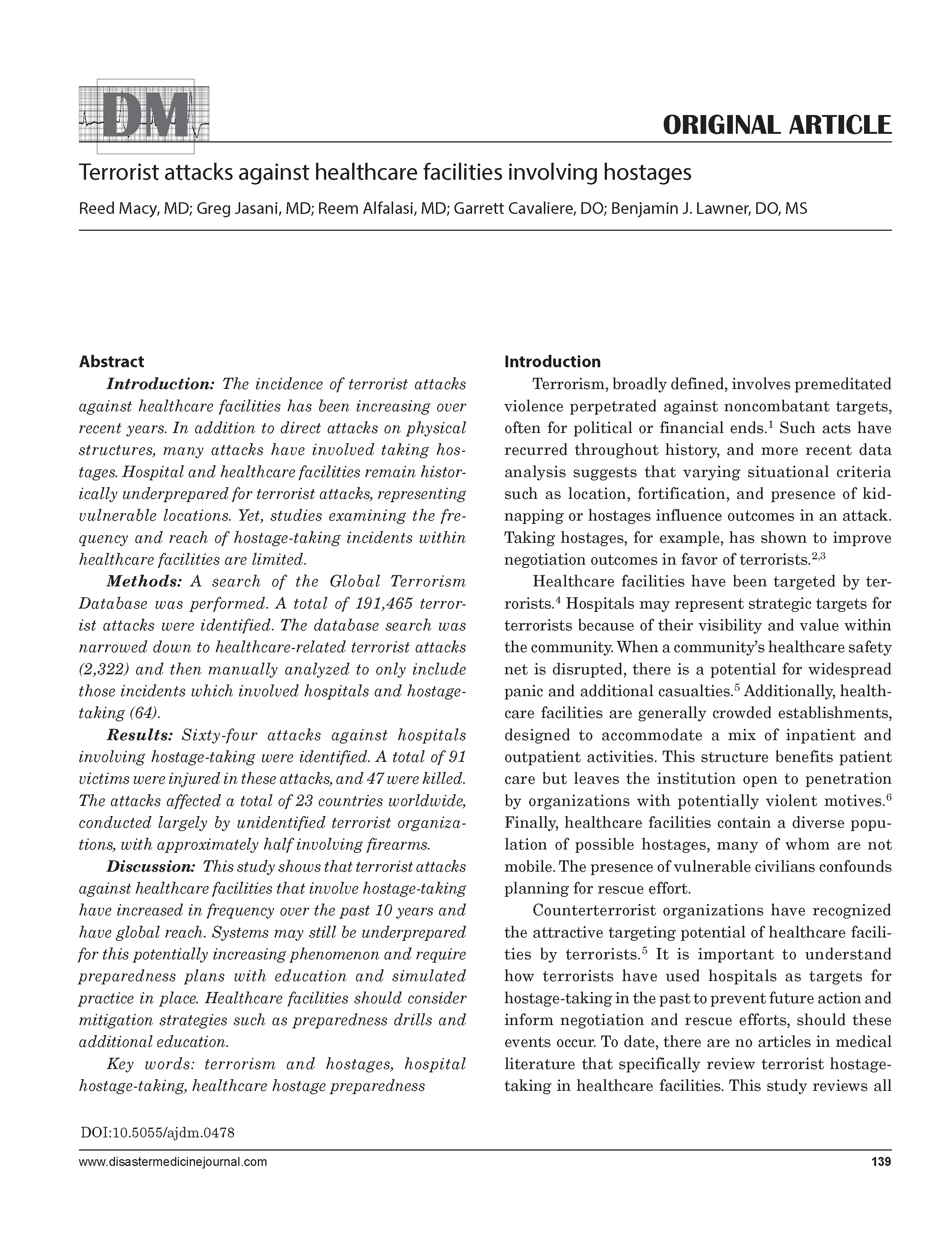Terrorist attacks against healthcare facilities involving hostages
DOI:
https://doi.org/10.5055/ajdm.0478Keywords:
terrorism and hostages, hospital hostage-taking, healthcare hostage preparednessAbstract
Introduction: The incidence of terrorist attacks against healthcare facilities has been increasing over recent years. In addition to direct attacks on physical structures, many attacks have involved taking hostages. Hospital and healthcare facilities remain historically underprepared for terrorist attacks, representing vulnerable locations. Yet, studies examining the frequency and reach of hostage-taking incidents within healthcare facilities are limited.
Methods: A search of the Global Terrorism Database was performed. A total of 191,465 terrorist attacks were identified. The database search was narrowed down to healthcare-related terrorist attacks (2,322) and then manually analyzed to only include those incidents which involved hospitals and hostage-taking (64).
Results: Sixty-four attacks against hospitals involving hostage-taking were identified. A total of 91 victims were injured in these attacks, and 47 were killed. The attacks affected a total of 23 countries worldwide, conducted largely by unidentified terrorist organizations, with approximately half involving firearms. Discussion: This study shows that terrorist attacks against healthcare facilities that involve hostage-taking have increased in frequency over the past 10 years and have global reach. Systems may still be underprepared for this potentially increasing phenomenon and require preparedness plans with education and simulated practice in place. Healthcare facilities should consider mitigation strategies such as preparedness drills and additional education.
References
Middle East Institute: What is “terrorism”?: Terrorism and human rights. Available at http://www.jstor.com/stable/resrep19954.8. Accessed July 12, 2021.
Santifort C, Sandler T: Terrorist success in hostage-taking missions: 1978-2010. Public Choice. 2013; 156(1/2): 125-137.
Gaibulloev K, Sandler T: Hostage taking: Determinants of terrorist logistical and negotiation success. J Peace Res. 2009; 46(2): 739-756.
Cavaliere GA, Alfalasi R, Jasani GN, et al.: Terrorist attacks against healthcare facilities: A review. Health Secur. 2021; 19(5): 546-550.
Richard H: Protect thyself. Hosp Health Netw. 2002; 38: 16-17. 6. Torjesen I: Hospitals and GP surgeries may be targets for terrorists, police warn. BMJ. 2017; 357: j2873.
Martin R: Soft targets are easy terror targets: Increased frequency of attacks, practical, preparation, and prevention. Forensic Res Criminol Int J. 2016; 3(2): 273-278.
Terrorism: Our world in data web site. 2019. Available at https://ourworldindata.org/terrorism. Accessed July 12, 2021.
Cronin A: Hostage negotiations and other talks with terrorists: Price vs principle. Georget J Int Aff. 2015; 16(1): 104-112.
Institute for Counter Terrorism: The American Hostage Policy—A historic pro-active shift. 2020. Available at www.jstor.org/stable/resrep30930. Accessed July 12, 2021.
Australian Strategic Policy Institute: Negotiating with terrorists.
Available at http://www.jstor.com/stable/resrep23114.16. Accessed July 12, 2021.
Neumann P: Negotiating with terrorists. Foreign Aff. 2007; 86(1): 128-138.
The Joint Commission: Healthcare at the crossroads: Strategies for creating and sustaining community-wide emergency preparedness systems. 2003. Available at http://www.jointcommission.org/NR/rdonlyres/9C8DE572-5D7A-4F28-AB84-3741EC82AF98/0/emergency_preparedness.pdf. Accessed February 10, 2022.
The Joint Commission: Standing together: An emergency planning guide for America’s communities. 2005. Available at https://pdf4pro.com/amp/view/standing-together-an-emergency-planningguide-for-3b2e8b.html. Accessed February 10, 2022.
Ingrassia P, Mangini M, Azzaretto M, et al.: Hospital disaster preparedness in Italy: A preliminary study utilizing the World Health Organization hospital emergency response evaluation toolkit. Minerva Anestesiol. 2016; 82(12): 1259-1266.
Bin Shalhoub AA, Khan AA, Alaska YA: Evaluation of disaster preparedness for mass casualty incidents in private hospitals in Central Saudi Arabia. Saudi Med J. 2017; 38(3): 302-306.
Kollek D, Cwinn A: Hospital emergency readiness overview study. Prehosp Disaster Med. 2011; 26(3): 159-165.

Published
How to Cite
Issue
Section
License
Copyright 2007-2025, Weston Medical Publishing, LLC and American Journal of Disaster Medicine. All Rights Reserved.

